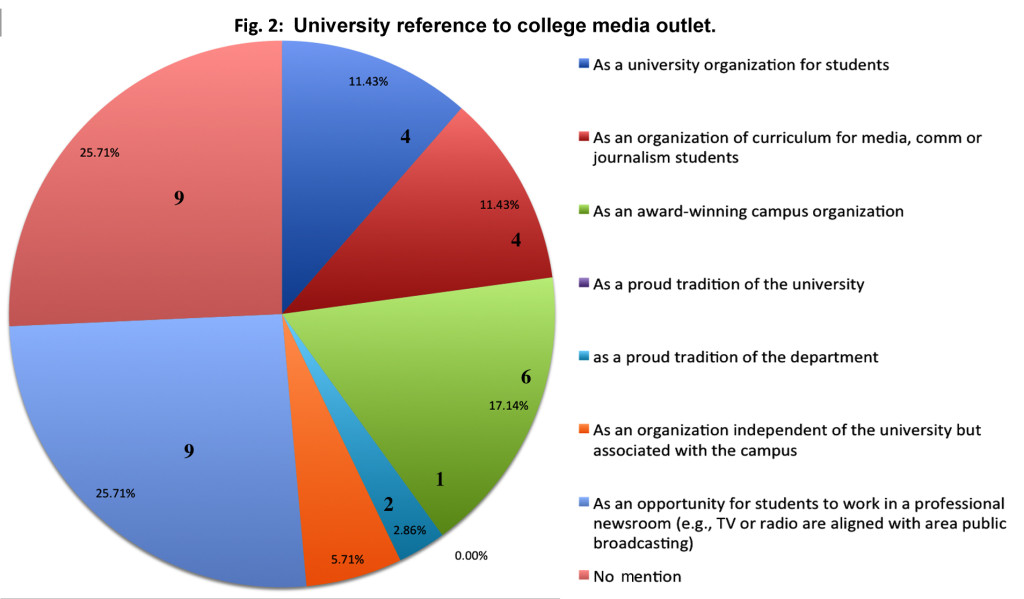Examining the Social Media Linking College Media to ‘Home’
Carol Terracina-Hartman
Lock Haven University of Pennsylvania
Robert G. Nulph
Missouri Western State University
 ABSTRACT: Successful college media programs, when judged against their peers, are located in academic departments with faculty-level advisors (Terracina-Hartman and Nulph 2013; Kopenhaver 2015). This study aims to examine communication practices and messages of universities and academic departments that promote these top college media outlets using social media tools. Which is preferred: Facebook or Instagram for celebrating an award? Does a university tag a student newspaper? Or does the department take the lead in announcing? Or does a college newspaper post its good news, tag its home institution, and then academic departments and colleges like, share, retweet, repost and tag? Perhaps the institution, department, and/or student media outlet chooses none of these, making them virtually invisible? The posts – whether celebratory, recruiting, spotlighting an alum, or introducing editors – enhance not only visibility for the college media program, but also produce a level of association between student media and their home institutions.
ABSTRACT: Successful college media programs, when judged against their peers, are located in academic departments with faculty-level advisors (Terracina-Hartman and Nulph 2013; Kopenhaver 2015). This study aims to examine communication practices and messages of universities and academic departments that promote these top college media outlets using social media tools. Which is preferred: Facebook or Instagram for celebrating an award? Does a university tag a student newspaper? Or does the department take the lead in announcing? Or does a college newspaper post its good news, tag its home institution, and then academic departments and colleges like, share, retweet, repost and tag? Perhaps the institution, department, and/or student media outlet chooses none of these, making them virtually invisible? The posts – whether celebratory, recruiting, spotlighting an alum, or introducing editors – enhance not only visibility for the college media program, but also produce a level of association between student media and their home institutions.
Scholars increasingly have documented dialogic principles of university systems with potential students in recent years, finding that first impressions persist, influencing the opinions of those applicants who later become first-year students throughout their years on campus (Aquilani and Lovari 2009; Gordon and Berhow 2009). Additional research finds that much web communication targets donors, alums, and research-granting agencies before addressing student or potential student audiences (Hewitt and Forte 2009; Will and Callison 2006). Yet highlighting student achievement through the web can be a key mark of visibility for any student program and critical to department recruitment (Kent and Taylor 1998). Continue reading “(Research Vol. 56) Posting, Tweeting, Instagraming”
 Abstract: With prior research indicating successful college media programs, as judged against their peers, tend to be housed in academic departments with faculty-level advisors, this study examines how college media outlets are presented, promoted, and used for recruiting within departments and home institutions. How visible are they? Primarily housed in political science, visibility has expanded as a research interest with the advent of social media. For this study, visibility is “organizational behavior to present content communally” (Brunner and Boyer 2008). After examining the top 35 award-winning programs, results indicate low levels not only of presence and visibility, but also self-promotion: college media references are two clicks from department homepage (46%) and 3-4 clicks from university homepage (57%). Media outlets most often post recruitment information (33%). These results suggest a need for growth in promotion, public relations, and associations.
Abstract: With prior research indicating successful college media programs, as judged against their peers, tend to be housed in academic departments with faculty-level advisors, this study examines how college media outlets are presented, promoted, and used for recruiting within departments and home institutions. How visible are they? Primarily housed in political science, visibility has expanded as a research interest with the advent of social media. For this study, visibility is “organizational behavior to present content communally” (Brunner and Boyer 2008). After examining the top 35 award-winning programs, results indicate low levels not only of presence and visibility, but also self-promotion: college media references are two clicks from department homepage (46%) and 3-4 clicks from university homepage (57%). Media outlets most often post recruitment information (33%). These results suggest a need for growth in promotion, public relations, and associations.